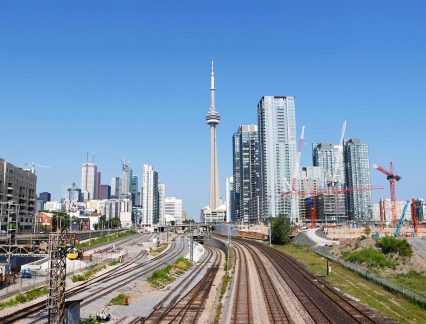
Canada is planning to spend C$180bn on its infrastructure over the next 12 years. Melodie Michel looks at where the money will go and what opportunities this strategy will present to foreign investors.
In its 2016 budget, Justin Trudeau’s Liberal government announced a massive infrastructure investment drive: hundreds of billions of Canadian dollars would be poured into roads, ports, public transit, renewables and other sectors. It was the first time in years that Canada chose to operate on a deficit in order to stimulate growth. Historically, Canadian governments have led rather conservative budgets, which – along with very rigorous banking regulations – helped the country come out of the global financial crisis relatively unscathed.
This strategy worked well as long as commodity prices were high (in 2016, over 25% of the country’s exports were raw commodities) and the relationship with the US was smooth (in the same year, 76.2% of exports went to Canada’s southern neighbour). But this balance has been challenged in recent years: first, the commodity downturn has made it more difficult to create revenue without adding value. Second, the election of Donald Trump – a candidate whose ideology is very far from Trudeau’s – as president of the United States in November 2016, followed by his administration’s demands to renegotiate the North American Free Trade Agreement (Nafta), has put Canada’s most important trade relationship at risk.
“On the positive side we have a very large market and a wealthy neighbour, but on the negative side we face what bankers would call concentration risk,” Alexander Malaket, president of Opus Advisory Services International, tells GTR.
So Trudeau’s government decided it was time for a change. “As important as government help is, what the Canadian middle class needs most is strong economic growth. That is why the government will make new investments in infrastructure from coast to coast to coast,” reads the government’s 2016 budget.
In 2017, the budget clarified allocations: C$33bn would be delivered through bilateral agreements between the federal government and the provinces, and over the next 11 years C$20.1bn would be spent on public transit, C$9.2bn on green infrastructure, C$1.3bn on social infrastructure and C$2.4bn on northern and rural infrastructure. Some of the investment, though there are no details on how much, will also be spent on “information infrastructure”, to improve data technology and help importers, exporters and carriers streamline processes.
Canada Infrastructure Bank
Another important part of the government’s plan is the creation of the Canada Infrastructure Bank, the mandate of which, according to its website, is to invest in projects that “will contribute to [the country’s] long-term economic growth and support the creation of good, well-paying jobs for the middle class”. So far, only the bank’s chairperson has been publicly announced: Janice Fukakusa, who retired from her job as chief administrative officer and chief financial officer of Royal Bank of Canada (RBC) in January 2017.
However, details on the bank’s structure and the type of investment it will offer are thin on the ground. Despite submitting a list of questions about specific financial instruments, the only information GTR has been granted from the government is that the bank is expected to be operational by the end of 2017. “The bank will develop its own organisational structure once operational and, as per its legislation, will be able to use a wide breadth of financial instruments such as debt and equity investments, loan guarantees, and other innovative tools. The specific financial instruments used will depend on what makes most sense for any given project,” a government spokesperson says.
Canadians don’t seem to know much more about the future plans. “The Canada Infrastructure Bank is a little bit of an enigma to us too,” says Benjamin Gross, partner at Lavery’s business law group and co-chair of Lavery’s infrastructure law group. However, he seems convinced that the lack of detail on the bank, more than a year after it was announced, is a good sign.
“The government has understood that sending ministers who may not be that aware of how infrastructure works into the market to try to get funds from foreigners or investors is not the best way to do things. So they’ve actually gone out and got themselves some high-level infrastructure experts. I don’t believe this is necessarily going to be a bank in the way we understand it generally. I think this is going to be a conglomeration of excessively knowledgeable individuals who will create a way to invest in infrastructure that will bring back revenue,” he tells GTR.
Gross believes the bank could follow the model of Quebec’s Caisse de Dépôts et de Placements (CDPQ), which was created in 1965 to manage the funds of the province’s pension plan and today has C$286.5bn of assets and investments around the world and an annualised five-year return of 10.6%. “It has widely been reported in the media that they’re talking to each other, so my sense of this is that that’s the model that they’re building on, and they’ll create something that is very good for investors,” he says.
Foreign investment
Though the government hasn’t put a number on the foreign investment it hopes to attract, Canada’s infrastructure deficit is estimated at around C$200bn, and so far only C$35bn of public money has been committed. The rest will have to come from private sources within and outside of the country.
While the country has made it clear it is open to foreign money, it also wants to diversify the sources of these funds. Malaket explains: “We looked at this as an opportunity to diversify beyond the US, which will remain an important trading partner. One of the things that’s added urgency to this is the nature of too much of the current rhetoric in Washington. You have no choice but to say, if that’s the nature of the dialogue, with inflammatory comments about Nafta, a push for bilateralism and some degree of disregard for established rules of international commerce, we need to look seriously at other opportunities.
“The need to diversify is not new in Canada, but the context and the relationship dynamic has perhaps never been more supportive of such an argument. Like other jurisdictions, we are now looking at alternatives, such as a free trade agreement with China, opportunities under the Canada-Europe trade agreement (Ceta), Latin America and Mercosur, South Asia and other markets.”
While Latin America is typically more of an investment destination than a source of foreign investment, Europe and Asia are strong contenders for taking a share of the US’ interest in Canada.
Within his practice, Gross has seen a lot of interest from European companies, particularly in the renewables sector. “In Quebec we’re working a lot with French companies including construction companies that are actively involved in the infrastructure market, renewables, biomethane, etc. They come to our office and we give them an overview of the Quebec market. Even French banks like Natixis have come here to talk to us and we’ve been involved in a project with them,” he says.
Gross explains that this is helped by the significant cultural change over recent years in the way that Canada evaluates bids, partly because of corruption scandals in the construction industry in other parts of the world (think Brazil and Odebrecht).
“Many governments were being highly scrutinised. As a result, the Canadian government had to find more objective criteria and create new processes to ensure that companies were being fair and there wasn’t any collusion,” he says.
Whereas in the past Canadian companies like Bombardier would have had the upper hand, today more foreigners are awarded bids as the government shifts its focus to selecting companies that meet quality, experience and cost-related criteria. “That is a major shift in the way Canada operates,” says Gross.
In a June 2017 interview with Canada’s National Post newspaper, China’s ambassador to Canada Lu Shaye said Chinese investors had little interest in the country, due to what he described as lengthy regulatory processes required for Canadian infrastructure. But this does not align with the experience of people arranging investments on the ground.
Gross has seen a lot of interest from China and the rest of Asia in Canadian projects, particularly mining developments in the north of the country. Not usually placed under the “infrastructure” umbrella, mines form part of the government’s plan to improve infrastructure for northern populations and First Nations.
Gross says he is working with four Asian banks, as well as a large Asian investment fund, who are actively looking for mining projects to invest in now that commodity prices are recovering. “In Quebec we have Le Plan Nord, which was supposed to bring in a tremendous amount of investment in the mining industry. The reality is that the price of the commodities that would have been mined went down so much that it’s been a little bit tougher to generate money in that industry. But we know that in Northern Canada there is huge potential for all sorts of different mining operations. One of our clients is actively seeking C$3.5bn for a project which would include the building of a tremendously large port on the tip of Northern Quebec,” he says.
As a sign that times are changing for Canadian mining, Montreal-based firm Osisko signed in June the C$1.13bn acquisition of diamond, gold and silver assets from US private equity firm Orion Mine Finance Group, a transformational transaction that Osisko CEO Sean Roosen says the company had been waiting to close for three years.
“The mining industry is moving; the question is: when will the real money come pouring in?” asks Gross.
Lack of detail
Perhaps what is needed to bring in more of the “real money” is more detail on the various projects looking for investment. Gross admits to being a little bit “in limbo” about the exact projects that will be prioritised by the government. He believes roads will receive a lot of attention, and port developments have already begun. But it is unclear whether the projects currently coming online are part of the 2016 budget infrastructure push, or a result of previous budget allocations to provinces and cities.
“There have been requests for further details not only on the infrastructure side, but also about the Canadian Infrastructure Bank: how it would be capitalised, how the money would be distributed – it’s all under discussion. There are numbers being thrown out and the question is, is that duplicate counting of money that’s already been pledged to subnational authorities?” asks Malaket.
Canadian and international banks don’t seem to have much more information: CIBC, BMO, TD Bank, Scotiabank and RBC all declined to comment, while Bank of America Merrill Lynch, which was initially interested in an interview, later decided it was “a bit premature” to discuss this issue with GTR.
Some provinces may start offering tenders on projects faster than others, depending on whether or not they have accepted the public-private partnership (PPP) model. Ontario, for example, is “moving forward at a very rapid pace”, says Gross, while Quebec is still figuring out the best way to have public and private entities collaborate for efficiency.
“Foreigners are still investing, just at a slower pace, with the hope that ultimately it will lead to more solid infrastructure. There’s a bit of frustration in the sense that they want more projects coming out quickly. People want to invest their money, but I think that it’s more responsible as a government to take a bit more time and invest responsibly,” he adds.











